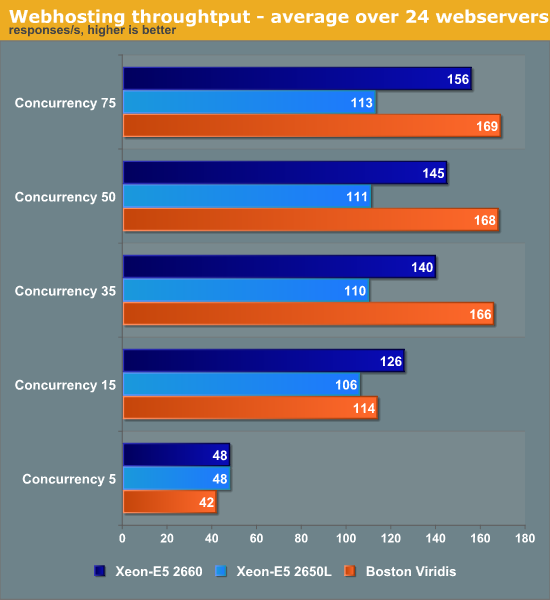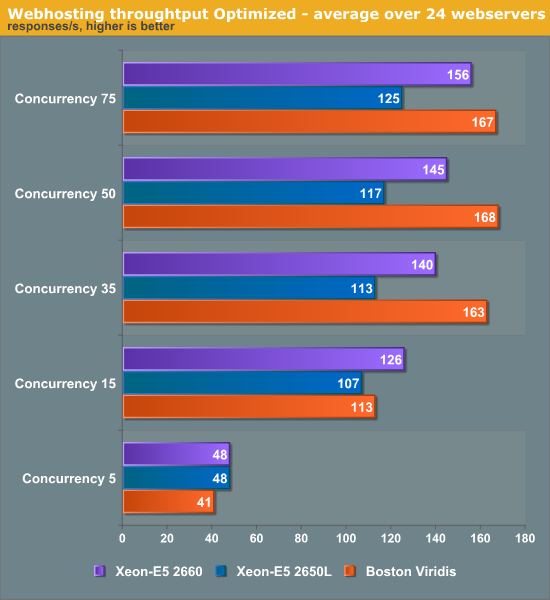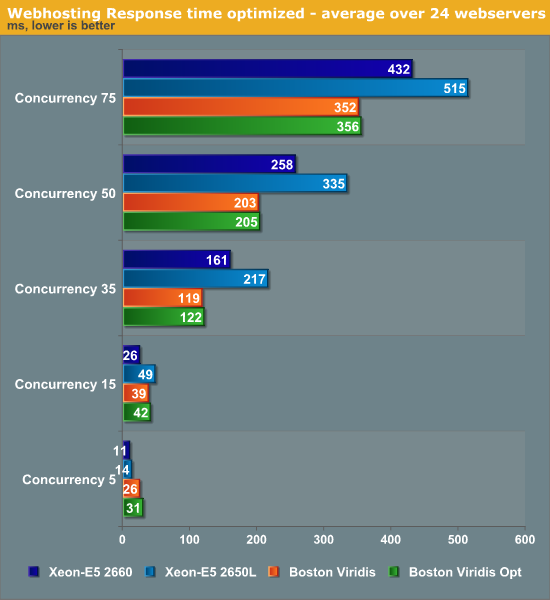Calxeda's ARM server tested
by Johan De Gelas on March 12, 2013 7:14 PM EST- Posted in
- IT Computing
- Arm
- Xeon
- Boston
- Calxeda
- server
- Enterprise CPUs
The Results that Matter
Before you jump ahead to the charts below, we suggest taking some time to properly interpret the results. First of all, we simulate between 5 to 15 "busy" users on the web server per second. As a user clicks somewhere on the website, this can result in a few requests or tens of requests. For example, accessing the forum on the website results in two simple "GET" requests, while posting a reply results in an avalanche of 56 POSTs and GETs. That is why we report performance in "responses per second". Responses are somewhat similar from the CPU load point of view if you look at a statistically large enough number of them. User actions are so wildly different that in some cases performing two user actions per seconds can require more processing power and network bandwidth than 20 user actions per second.

At the low concurrencies, the Intel machine leverages turboboost and its exceptionally high per core performance. At the higher web loads, the total throughput of the 96 (24x quad-core SoCs) ARM Cortex-A9 cores is up to 50% higher than the low power 32 thread/16 core (2x Octal core) Xeons. Even the mighty 2660 cannot beat the herd of ARM SoCs.
While we have lots and lots of experience with x86 servers, we had almost none with ARM based servers, so we met up with the people of Calxeda engineering and got some valuable optimization tips. It turns out that the internal switch fabric can be tuned in various ways. For example, the link speed from one node is by default set to 2.5 gbit/s, which is rather high considering that we are mostly CPU limited and use less than 0.5Gbit/s per node. Setting the link speed of each node to 1Gbit/s should lower power and gives more than enough bandwidth. We also updated to a slightly newer kernel (155) from the Calxeda kernel PPA (Personal Package Archive). This allowed us to make use of Dynamic Voltage and Frequency Scaling (DVFS, P-states) using the CPUfreq tool. First let's see if all these power saving tweaks have reduced the total throughput.

The changes did not give any boost in throughput (in many cases the scores might even be slightly slower), but the changes might lower power use and/or response times. Let's look at that next.
Response Times

Again, the Intel machine performs better at lower concurrencies, but our ARM server delivers lower response times at high load. Our optimizations have had no effect on response times.










99 Comments
View All Comments
thenewguy617 - Wednesday, March 13, 2013 - link
I would like to see the results with the website running on bare metal. I would like to, but I don't believe you when you say the virtualization overhead is minimal.Also, did you include the power used by the switch? as we scale the xeon cluster we will add a lot of cost and power in the network, however Calxeda fabric should scale for free.
thebeastie - Thursday, March 14, 2013 - link
I think a lot of you are missing the main point or future potential of this server technology. And that is that intel like to make an absolute minimum of $50 per CPU they make, in server CPUs it's more like $300.These Arm CPUs are being sold at around $10 a CPU.
Sure Caldexa have gone the hard yards making such a server and want a lot of money for it. BUT once these ARM servers are priced in relative context of their actual CPu costs its going to be the biggest bomb drop on Intels sever profits in history.
Silma - Thursday, March 14, 2013 - link
Assuming you are right and ARM is becoming so important that it can't be ignored, what's to prevent Intel to produce and sell ARM itself? In fact what's to prevent Intel to produce the best ARM socs as it has arguably the best fabs?There are rumors that Apple is asking Intel to produce procs for them, this would certainly be very interesting if it proves to be true.
thebeastie - Friday, March 15, 2013 - link
The fact that Intel would practically look at other businesses then produce SoC/CPUs for $10 each, x86 or ARM based doesn't matter in the face of such high portability of code.Metaluna - Friday, March 15, 2013 - link
The problem is that ARM cores are pretty much a commodity, so ARM SoC pricing is inevitably going to end up as a race to the bottom. This could make it difficult for Intel to sustain the kind of margins it needs to keep it's superior process R&D efforts going. Or at least, it would need to use its high-margin parts to subsidize R&D for the commodity stuff which could get tricky given the overall slowing of the market for the higher end processors. I think this is what's happening with the supposed Apple deal. There have been reports that they have excess capacity at 22nm right now so it makes sense to use it. And, since Apple only sells its processors as part of its phones and tablets, it doesn't directly compete with x86 on the open market.Of course, all the other fabs are operating under the same cost constraints, so there would be an overall slower pace of process improvements (which is happening anyway as we get closer to the absolute limits at <10nm).
wsw1982 - Wednesday, April 3, 2013 - link
And so does those companies, run into bottom. What can they do to even their R&D, by put the server chip into mobile phone?Krysto - Monday, March 18, 2013 - link
Yup. This is actually Intel's biggest threat by far. It's not the technical competition (even though Intel's Atom servers don't seem nearly as competitive as these upcoming ARM servers), but the biggest problem by far for them will be that they will have to compete with the dozen or so ARM server companies on price, while having more or less the same performance.THAT is what will kill Intel in the long term. Intel is not a company built to last on Atom-like profits (which will get even lower once the ARM servers flood the market). And they can forget about their juicy Core profits in a couple of years.
wsw1982 - Wednesday, April 3, 2013 - link
So your argument is because the ARM solution is more expensive than Intel solution now, therefore it must be cheaper than Intel solution in the feature? The mobile ARM is cheap, so does the Intel mobile chips.Silma - Thursday, March 14, 2013 - link
1300$ difference / server, that's a lot electricity you have to spare to justify the cost, especially as it is better that Xeon servers only in a few chosen benchmarks.Can't see how this is interesting in production environment.
It's more for testing / experimenting I guess;
Wilco1 - Thursday, March 14, 2013 - link
The savings are more than just electricity cost, you also save on cooling costs and can pack your server room more densely. If you do a TCO calculation over several years it might well turn out to be cheaper overall.This is the first ARM server solution, so it's partly to get the software working and test the market. However I was surprised how competitive it is already, especially when you realize they use a relatively slow 40nm Cortex-A9. The 2nd generation using 28nm A15 will be out in about 6 months, if they manage to double performance per core at similar cost and power then it will look even better.